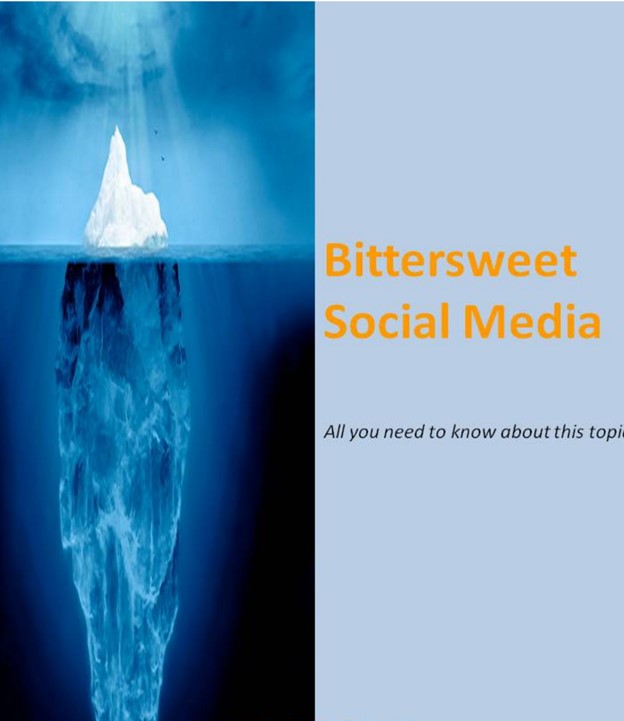Bittersweet Social Media

Bittersweet Social Media
Bittersweet Social Media – This book offers the essential information about social media, it does not contain highly technical information or analytical formulas but, in contrast, it offers an explanation of the new communication system and also provides ideas to spark off individual researches.
I wanted to create a book that was simple, effective and brief; focused on analyses and explanations of social media’s meaning, the idea behind them, and the influence they have on people’s lives.
Social media (SM) system is a next step of the Internet evolution and it represents the result of the interaction between new communication needs and technology development (based on internet).
Many important events occurred in the USA in 1969. For example, the military operations in Vietnam, the moon landing, the election of Nixon as the 37th President of the United States, and the Woodstock concert.
However, few remember that in that year four American universities connected their PCs together in one single network. This network was the civil implementation of an original military project, designed by ARPA (Advanced Research Project Agency).
This military project had the purpose of keeping the Pentagon information up and running also after a hypothetical nuclear attack from foreign countries. This is because the multiple locations, connected to each other, provided a solution of disaster recovery where essential data were stored in separate places and restored if needed.
The Internet came years later when it became easier to connect networks using the TCP/IP protocol, and it became popular with the development of browsers and search engines.
Initially, the Internet was conceived and developed to connect only machines, and to allow the exchange of information to make jobs easier and economically convenient for companies.
In just a few years, this technology affected company business on the one hand, and people’s socialization, interests and mobility on the other.
Some people made a lot of money from the Internet, and new companies, were created, for example: Larry Page and Sergey Brin (Google founders); Jeff Bezos (Amazon founder); Masayoshi Son (President of SoftBank); Pierre Omidyar (eBay founder and chairman); Hiroshi Mikitani (Rakuten co-founder and CEO); Mark Zuckerberg (co-founder of Facebook); Ma Huateng (founder of Tencent Inc.).
The Internet is only a technology, and therefore impersonal, but social media (SM) have changed this trait. SM category is made up of many ‘mediums’ (for this reason I will always address SM as a plural), which will be discussed individually in this book. They have enriched the ‘Information Age’ and they are pushing society toward one based on ‘digital interactions between people’.
SM were created to support the circulation of information between people, who need to register their profile and prove their identity for the interactions. For example, it is possible to login to some websites, or sell products and services, using a personal Internet profile from another website (e.g. using the personal Facebook or LinkedIn profile).
In order to keep and develop business and social relationships with hundreds of contacts, SM usage is growing because they are:
a) Handy;
b) Cheap;
c) Effective.
One different opinion is Solis, who stated in 2007: “Social Media is about Sociology and not Technology”. He sustains that any media, in general, exists because they are used for people’s interactions and, furthermore, a medium is developed to reach people and not an audience.
This book analyses this kind of statements and ideas, verifying the importance of technology and if it plays an important role in increasing the usage of SM. Nowadays, it looks like the development of technology supports the increase of the human interactions, for example: mobile phones and software applications, tablet computers, fast Internet connections, and the ability to send content as a combination of images and audio.
During my research, I found a very interesting quote: “We don’t have a choice on whether we do social media, the question is how well we do it.” (Qualman, 2010). In summary, the author’s message is that SM represents “the biggest shift since the Industrial Revolution”. I completely support this definition because, as I demonstrate in this book, the implementation of SM has changed major aspects of our society and economy. They are so powerful that they can hurt or promote people and companies’ reputations and change the quality of services or their perception.
Other authors, like Centorrino and Romero (2012) believe that SM have redefined communication in terms of time and space (distance), because they have created new places for meetings and a new way to interact, watch TV, listen to music, read a newspaper, or get an education or training.
Specifically, they are part of a group of theorists who believe that the Internet has compressed time and space (in terms of distance) between users, just as all previous systems of transportation have done. For example, when the railways were developed, they reduced the time and space needed to transport goods and people and, years later, the development of airplane reduced the two elements even more.
This means that the progress and developments of technology contribute to reducing the importance and the role of Time and Space in the transportation system. Same analogy can be used for communication.
Indeed, in the past the creation and development of new methods of communication (e.g. papyrus, smoke signals and letters) the purpose of reducing the time needed by message to travel and to spread the message over the distance. The Internet has made a significant contribution in this sense because it makes it possible to distribute messages quickly and over a long distance.
In this case, the Internet represents the vehicle which transports the message (e.g. information, songs, pictures, documents, opinions and e-books, commands, and instructions), and SM are a method of communication.
For one of the world’s most prominent social theorists, Bauman (2000), time and space compression also affects the transformation of people’s lives. He explains that people use SM for varied reasons, for example for buying, interacting with others, finding, and providing information, and for playing; this use affects people’s behavior and habits.
One of the most interesting of Bauman’s views is that modern society is becoming ‘exterritorial and not more contained by the space’. Specifically, the element of ‘space’ is about to disappear from our society because it is becoming less important than it was a few years ago.
To explain this point more effectively, let’s analyze four unusual ways to communicate between people: a face–to-face conversation implies that two or more people are in proximity (space has a primary role in this case). If they decide to communicate with a letter, the social interaction is compressed into words on paper, the letter takes time to reach the receiver and it has a space (distance) to cover before reaching the destination.
In contrast, an email drastically reduces the time needed for interaction and the space is not influential for the purpose of communication. If the same people decide to communicate using online chat, well, the two elements (time and space) are almost non-existent.
The continuous technological evolution makes people’s habits dynamic, and this changes our society’s organization creating a ‘Liquid Society’. Bauman also suggests that SM have created a double life, because in addition the real one, there is a digital one. For example, people can socialize with friends in one place and be also connected to another network, using tweets, instant chats, business emails, dating applications, picture postings and tags.
A scary or intriguing part (depending on the personal view of the ‘Internet evolution’) is that individual opinions, tastes, interests, and hobbies are exposed and available to everyone with the Internet access, and this makes it easier to recreate and analyze identities.
SM can also show other information such as: places visited and time of visit, current employer name, date of birth, current living city, siblings, and many others. This also means that personal life can be available for comments, to be recalled at any time in a discussion or comment and saved…just in case.
More of What’s Inside…
![]() Social Media Today
Social Media Today
-1.1 Phenomenon Definition
– 1.1.1 Facebook
– 1.1.2 YouTube
– 1.1.3 Twitter
1.2 Why now?
![]() 1.3 Current Uses
1.3 Current Uses
1. Entertainment.
2. Business.
3. Knowledge.
![]() Chapter Two
Chapter Two
![]() The Rise of Social Media’s Influence
The Rise of Social Media’s Influence
2.1 Communication Essentials
1) Linear Model of Communication
a) Information source
b) Transmitter
c) Channel
d) Receiver
e) Destination
f) Noise
2) Interactive Model
3) Transactional Model
![]() 2.2 The Power of Social Media
2.2 The Power of Social Media
2.3 How Social Media Affect Interpersonal Communication
2.3.1 Language and Behavior
2.4 Social Media and Traditional Media
2.4.1 Analysis of Traditional Media
2.5 Market opportunity and Users profile
![]() Chapter Three – Impact on People’s Lives
Chapter Three – Impact on People’s Lives
3.1 Are Social Media for Everyone?
3.2 Political impact
3.3 Marketing impact
3.3.1 Consumer purchase process
3.3.2 Companies
3.4 Social Impact
![]() And Much More…
And Much More…
The “Bittersweet Social Media” eBook is now available in PDF eBook format. Get instant access to this life changing eBook today for only $27.
Order “Bittersweet Social Media” eBook and start changing your life for the better starting right now!
Our 100% Money Back Guarantee:

Try it Risk Free Today! If you purchase today, your purchase is 100% guaranteed.
After reading the eBook and you are not satisfied just ask and I will be glad to give you a full refund.
All purchases may be refunded within 30 days of purchase, meaning that if you think your new eBook is not as good as I claim, you will get every cent you paid back.
If for any reason you decided within 30 days that “Bittersweet Social Media” is not for you, simply notify us by email and we will gladly refund your money – no questions asked. That is our Ironclad Guarantee!
The risk is entirely ours! You absolutely have nothing to lose!
90 Pages of Wild-Eyed Information About Social Media You Don’t Know…
Click on the Buy Button Below for Instant Access! Only $27
Regards, Coyalita
Behavioral Health Rehabilitative Specialist & Addiction Counselor
Copyright © 2021-2023 Thresholdlivecoyalita.com All Rights Reserved Privacy Policy – Earnings Disclaimer – Terms of Use – Contact Us
Please note. The eBook is in PDF. file format. You need an Adobe Acrobat Reader to be able to read the eBook. If you do not have Adobe Acrobat Reader installed on your computer, you can download it at http://www.adobe.com. It is completely FREE.





